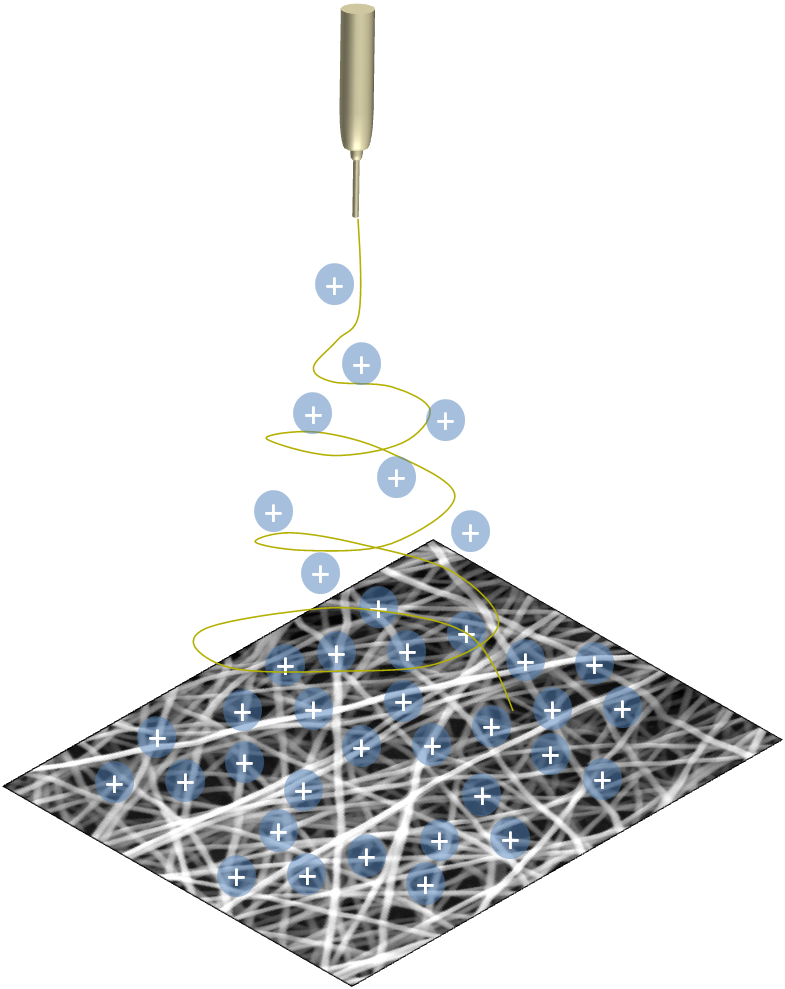Electrospinning is based on the presence of charges on the solution to stretch it across an electric field. In an ideal scenario, the charges on the deposited fibers are subsequently conducted away by the electrically grounded collector so that an electrically neutral surface is able to continue attracting the electrospinning jet. However, in practice, polymers which are normally poor electrical conductor tend to continue holding on to the charges immediately after deposition. Surface voltage of more than 1 kV has been recorded on electrospun fibers after 20 h [Schreuder-Gibson et al 2004]. Charge retention of the electrospun fibers may or may not be beneficial depending on the application. In air filtration, charge retention over extended period of time may be preferred as it improves filtration efficiency. However, charge retention may prevent fabrication of thick fiber mat or hinders precision electrospinning. Numerical simulation has shown that residual charges negatively impacts alignment of fibers collected using the parallel collector electrodes setup [Liu and Dzenis 2008].
Amount of charges on the electrospun fibers depends on several factors such as environment, corona discharge, parasitic electrospraying and material such as its moisture retention, conductivity, crystallinity, structure, presence of additives and others [Collins et al 2012]. Parasitic electrospraying in the form of solvent droplets carrying charges with it and depositing on the collector will also contributes to the total charges on the electrospun mat [Collins et al 2012].Gradual buildup of the charges within the fibers will either result in a termination of electrospinning due to the reduction in the potential field difference between the collector and the emitter or diversion of the electrospinning jet to other region of lower potential. Alternatively, there must be other avenues which the accumulated charges within the fibers are dissipated when it reaches a certain level. An auto-balancing of the the charges within the electrospun mat is through spark discharges between the fibers and the collector [Collins et al 2012]. Accumulation of the charge-carrying fibers on the collector can be regarded as a parallel plate capacitor filled with air. Base on this concept, a breakdown voltage may be estimated for a particular mat thickness. Filitov et al (2007) estimated that a fiber mat thickness less than 1 mm will have a breakdown voltage that is smaller than the potential difference in electrospinning. This cycle of charged fiber accumulation and discharge at the breakdown threshold maintains a stable electric charge on the electrospun mat.
Polarity of the charges does not seem to have a significant impact on charge amount and retention [Schreuder-Gibson et al 2004]. For application in air filtration Schreuder-Gibson et al (2004) used different configurations of electrospun polyacrylonitrile and polystyrene, ranging from single material, alternate sandwich layers and side-by-side bicomponent layer and both positive and negative high voltage for electrospinning. No distinct trend was observed across the tested configurations and charge polarity and all the electrospun materials retained surface voltage of more than 1 kV after 20 h. However, after 3 months, most of the materials recorded surface voltage of less than 100 V with the highest voltage retention of about +500 V for a bilayer negatively charged polystyrene and positively charged polyacrylonitrile electrospun fibers.
A factor influencing the amount of charge retention is the conductivity of the electrospun fibers which is in turn affected by other conditions. Polar polymer with its tendency to retain moisture, and thus more conductive, is more likely to exhibit low charge retention. Residual charges in Nylon 6, Nylon 66, polyurethane, polyethylene oxide and polycaprolactone was found to be near zero but for non-polar polymers such as polystyrene, polycarbonate and polyacrylonitrile were able to retain charges from a few days to more than a week [Tsai and Schreuder-Gibson 2003].
An electrospun material may exhibit different types of charge retention. Catalani et al (2007) carried out a detailed study on charges at the molecular level and at the fiber surface level on electrospun poly(butylene terephthalate) (PBT). Their tests showed that polarization can occur in the dielectric material PBT causing dipole orientation during electrospinning. Heating the membrane to the materials glass transition temperature causes the dipoles to relax and release charges that can be detected using thermally simulated current electrodes. Flipping of the membrane registered current with the opposite sign confirming the orientation of the dipoles. However, charges from dipole orientation are generally very low and in the pico scale level. Presence of residual charges have also been detected in electrospun poly(butylene terephthalate) membrane. As the temperature increases, the residual charges become more mobile and travel to the electrode where charge dissipation current was recorded. This dissipation current is highest close to the material melting point where charges trapped within the crystalline phase were released. The level of residual charge trapped in electrospun membrane is much higher than melt-pressed and solvent-cast film.
Published date: 05 August 2014
Last updated: 23 September 2014
▼ Reference
-
Catalani L H, Collins G, Jaffe M. Evidence for Molecular Orientation and Residual Charge in the Electrospinning of Poly(butylene terephthalate) Nanofibers. Macromolecules 2007; 40: 1693.
-
Collins G, Federici J, Imura Y, Catalani L H. Charge generation, charge transport, and residual charge in the electrospinning of polymers: A review of issues and complications. Journal of Applied Physics 2012; 111: 044701.
-
Filatov Y, Budyka A, Kirichenko V. Electrospinning of Micro- and Nanofibers: Fundamentals and Applications in Separation and Filtration Processes. Begell House, Redding, CT, 2007
-
Liu L, Dzenis Y A. Analysis of the effects of the residual charge and gap size on electrospun nanofiber alignment in a gap method. Nanotechnology 2008; 19: 355307.
-
Schreuder-Gibson H L, Gibson P, Tsai P, Gupta P, Wilkes G. Cooperative Charging Effects of Fibers from Electrospinning of Electrically Dissimilar Polymers. INJ Winter 2004; 39.
Open Access
-
Tsai P, Schreuder-Gibson H L. The Role of Fiber Charging on Co-electrospinning and the Resident Life of the Residual Charges from the Electrospinning Process. American Filtration and Separations Society Spring 2003 Meeting.
▲ Close list
 ElectrospinTech
ElectrospinTech
